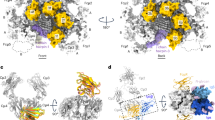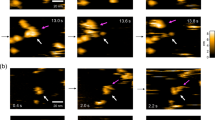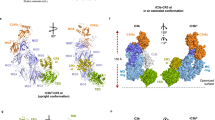Abstract
The immune response depends on the binding of opsonized antigens to cellular Fc receptors and the subsequent initiation of various cellular effector functions of the immune system. Here we describe the crystal structures of a soluble Fcγ receptor (sFcγRIII, CD16), an Fc fragment from human IgG1 (hFc1) and their complex. In the 1:1 complex the receptor binds to the two halves of the Fc fragment in contact with residues of the Cγ2 domains and the hinge region. Upon complex formation the angle between the two sFcγRIII domains increases significantly and the Fc fragment opens asymmetrically. The high degree of amino acid conservation between sFCγRIII and other Fc receptors, and similarly between hFc1 and related immunoglobulins, suggest similar structures and modes of association. Thus the described structure is a model for immune complex recognition and helps to explain the vastly differing affinities of other FcγR–IgG complexes and the FcεRIα–IgE complex.
This is a preview of subscription content, access via your institution
Access options
Subscribe to this journal
Receive 51 print issues and online access
$199.00 per year
only $3.90 per issue
Buy this article
- Purchase on Springer Link
- Instant access to full article PDF
Prices may be subject to local taxes which are calculated during checkout





Similar content being viewed by others
References
Huber, R., Deisenhofer, J., Colman, P. M., Matsushima, M. & Palm, W. Crystallographic structure studies of an IgG molecule and an Fc fragment. Nature 264, 415–420 (1976).
Metzger, H . Transmembrane signaling: the joy of aggregation. J. Immunol. 149, 1477–1487 (1992).
Isakov, N. ITIMs and ITAMs. The Yin and Yang of antigen and Fc receptor-linked signaling machinery. Immunol. Res. 16, 85– 100 (1997).
Gessner, J. E., Heiken, H., Tamm, A. & Schmidt, R. E. The IgG Fc receptor family. Ann. Hematol. 76, 231– 248 (1998).
Galon, J. et al. Soluble Fcγ receptors: interaction with ligands and biological consequences. Int. Rev. Immunol. 16, 87– 111 (1997).
Deisenhofer, J. Crystallographic refinement and atomic models of a human Fc fragment and its complex with fragment B of protein A from Staphylococcus aureus at 2.9- and 2.8Å resolution. Biochemistry 20, 2361–2370 (1981).
Sauer-Eriksson, A. E., Kleywegt, G. J., Uhlen, M. & Jones, T. A. Crystal structure of the C2 fragment of streptococcal protein G in complex with the Fc domain of human IgG. Structure 3, 265–278 (1995).
Burmeister, W. P., Huber, A. H. & Bjorkman, P. J. Crystal structure of the complex of rat neonatal Fc receptor with Fc. Nature 372, 379– 383 (1994).
Duncan, A. R., Woof, J. M., Partridge, L. J., Burton, D. R. & Winter, G. Localization of the binding site for the human high-affinity Fc receptor on IgG. Nature 332, 563–564 (1988).
Chappel, M. S. et al. Identification of the Fcγ receptor class I binding site in human IgG through the use of recombinant IgG1/IgG2 hybrid and point-mutated antibodies. Proc. Natl Acad. Sci. USA. 88, 9036–9040 (1991).
Lund, J. et al. Multiple binding sites on the CH2 domain of IgG for mouse Fcγ R11. Mol. Immunol. 29, 53– 59 (1992).
Greenwood, J., Clark, M. & Waldmann, H. Structural motifs involved in human IgG antibody effector functions. Eur. J. Immunol. 23, 1098– 1104 (1993).
Diamond, B., Boccumini, L. & Birshtein, B. K. Site of binding of IgG2b and IgG2a by mouse macrophage Fc receptors by using cyanogen bromide fragments. J. Immunol. 134, 1080–1083 (1985).
Gergely, J. & Sarmay, G. The two binding-site models of human IgG binding Fcγ receptors. FASEB J. 4, 3275–3283 (1990).
Sondermann, P., Huber, R. & Jacob, U. Crystal structure of the soluble form of the human Fcγ-receptor IIb: a new member of the immunoglobulin superfamily at 1.7 Å resolution. EMBO J. 18, 1095–1103 (1999).
Jefferis, R., Lund, J. & Pound, J. D. IgG-Fc-mediated effector functions: molecular definition of interaction sites for effector ligands and the role of glycosylation. Immunol. Rev. 163, 59–76 (1998).
Woof, J. M., Partridge, L. J., Jefferis, R. & Burton, D. R. Localisation of the monocyte-binding region on human immunoglobulin G. Mol. Immunol. 23, 319–330 (1986).
Maxwell, K. F. et al. Crystal structure of the human leukocyte Fc receptor, FcγRIIa. Nature Struct. Biol. 6, 437– 442 (1999).
Garman, S. C., Kinet, J. -P. & Jardetzky, T. S. Crystal structure of the human high-affinity IgE receptor. Cell 95, 951– 961 (1998).
Tamm, A. & Schmidt, R. E. IgG binding sites on human Fcγ receptors. Int. Rev. Immunol. 16, 57– 85 (1997).
Sarmay, G., Lund, J., Rozsnyay, Z., Gergely, J. & Jefferis, R. Mapping and comparison of the interaction sites on the Fc region of IgG responsible for triggering antibody dependent cellular cytotoxicity (ADCC) through different types of human Fcγ receptor. Mol. Immunol. 29, 633–639 ( 1992).
Sondermann, P., Jacob, U., Kutscher, C. & Frey, J. Characterization and crystallization of soluble human Fcγ receptor II (CD32) isoforms produced in insect cells. Biochemistry 38, 8469–8477 (1999).
Ghirlando, R. et al. Stoichiometry and thermodynamics of the interaction between the Fc fragment of human IgG1 and its low-affinity receptor FcγRIII. Biochemistry 34, 13320– 13327 (1995).
Edberg, J. C. & Kimberly, R. P. Cell type-specific glycoforms of FcγRIIIa (CD16): differential ligand binding. J. Immunol. 159, 3849–3857 ( 1997).
Ishizaka, T. & Ishizaka, K. Triggering from histamine from rat mast cells by divalent antibodies against IgE receptor. J. Immunol. 120, 800–806 ( 1978).
Hulett, M. D., Witort, E., Brinkworth, R. I., McKenzie, I. F. C. & Hogarth, P. M. Multiple regions of human FcγRII (CD32) contribute to the binding of IgG. J. Biol. Chem. 270, 21188–21194 (1995).
Cook, J. P. et al. Identification of contact residues in the IgE binding site of human FcεRIα. Biochemistry 36, 15579–15588 (1997).
Hulett, M. D., Brinkworth, R. I., McKenzie, I. F. & Hogarth, P. M. Fine structure analysis of interaction of FcεRI with IgE. J. Biol. Chem. 274, 13345–13352 (1999).
Kato, K. et al. Structural basis of the interaction between IgG and Fcγ Receptors. J. Mol. Biol. 295, 213– 224 (2000).
Tax, W. J. M., Willems, H. W., Reekers, P. P. M., Capel, P. J. A. & Koene, R. A. P. Polymorphism in mitogenic effect of IgG1 monoclonal antibodies against T3 antigen on human T cells. Nature 304, 445– 447 (1983).
Warmerdam, P. A. M., van de Winkel, J. G. J., Vlug, A., Westerdaal, N. A. C., Capel, P. J. A. A single amino acid in the second Ig-like domain of the human Fcγ receptor II is critical for human IgG2 binding. J. Immunol. 147, 1338– 1343 (1991).
Hulett, M. D. & Hogarth, P. M. The second and third extracellular domains of FcγRI (CD64) confer the unique high affinity binding of IgG2a. Mol. Immunol. 35, 989– 996 (1998).
Sutton, B. J. & Gould, H. J. The human IgE network. Nature 366, 421–428 ( 1993).
Keown, M. B., Henry, A. J., Ghirlando, R., Sutton, B. J. & Gould, H. J. Thermodynamics of the interaction of human immunoglobulin E with its high-affinity receptor FcεRI. Biochemistry 37, 8863–8869 (1998).
Henry, A. J. et al. Participation of the N-terminal region of Cε3 in the binding of human IgE to its high-affinity receptor FcεRI. Biochemistry 36,15568–15578 (1997).
Clynes, R., Dumitru, C. & Ravetch, J. V. Uncoupling of immune complex formation and kidney damage in autoimmune glomerulonephritis. Science 279 , 1052–1054 (1998).
Clynes, R. A., Towers, T. L., Presta, L. G. & Ravetch, J. V. Inhibitory Fc receptors modulate in vivo cytoxicity against tumor targets. Nature Med. 6, 443–446 (2000).
Woodle, E. S. et al. Phase I trial of a humanized, Fc receptor nonbinding OKT3 antibody, huOKT3γ1(Ala–Ala) in the treatment of acute renal allograft rejection. Transplantation 68, 608–616 (1999).
Reddy, M. P. et al. Elimination of Fc receptor-dependent effector functions of a modified IgG4 monoclonal antibody to human CD4. J. Immunol. 164,1925–1933 (2000).
Curnow, R. T. Clinical experience with CD64-directed immunotherapy. an overview. Cancer. Immunol. Immunother. 45, 210– 215 (1997).
Sondermann, P. & Jacob, U. Human Fcγ receptor IIb expressed in Escherichia coli reveals IgG binding capability. Biol. Chem. 380, 717–721 (1999).
Rutishauser, U. et al. The covalent structure of a human gamma G-immunoglobulin. 8. amino acid sequence of heavy-chain cyanogen bromide fragments H5-H7. Biochemistry 9, 3171–3181 (1970).
Collaborative Computational Project, Number 4. The CCP4 suite: programs for protein crystallography. Acta Crystallogr. D 50, 760– 763 (1994).
Navaza, J. AMoRe: an automated package for molecular replacement. Acta Crystallogr. A 50, 157–163 ( 1994).
Brunger, A. T. et al. Crystallography & NMR system: a new software suite for macromolecular structure determination. Acta Crystallogr. D 54, 905–921 ( 1998).
Kraulis, P. J. MOLSCRIPT: a program to produce both detailed and schematic plots of protein structures. J. Appl. Crystallogr. 24, 946 –950 (1991).
Merritt, E. A. & Murphy, M. E. P. Raster3D Version 2. 0. a program for photorealistic molecular graphics. Acta Crystallogr. D 50, 869– 873 (1994).
Barton, G. C. ALSCRIPT: a tool to format multiple sequence alignments. Protein Eng. 6, 37–40 ( 1993).
Acknowledgements
We thank R. E. Schmidt and T. Witte and the unknown myeloma patient for providing us with the monoclonal hIgG1, G. P. Bourenkov and H. D. Bartunik, MPG-ASMB DESY/Hamburg, for help with the diffraction measurements.
Author information
Authors and Affiliations
Corresponding author
Rights and permissions
About this article
Cite this article
Sondermann, P., Huber, R., Oosthuizen, V. et al. The 3.2-Å crystal structure of the human IgG1 Fc fragment–FcγRIII complex. Nature 406, 267–273 (2000). https://doi.org/10.1038/35018508
Received:
Accepted:
Issue Date:
DOI: https://doi.org/10.1038/35018508
This article is cited by
-
Perspective view of allogeneic IgG tumor immunotherapy
Cancer Cell International (2024)
-
Control of acute myeloid leukemia by a trifunctional NKp46-CD16a-NK cell engager targeting CD123
Nature Biotechnology (2023)
-
The unique properties of IgG4 and its roles in health and disease
Nature Reviews Immunology (2023)
-
Complement component C1q is an immunological rheostat that regulates Fc:Fc\(\gamma\)R interactions
Immunogenetics (2023)
-
Neutralizing Antibodies and Antibody-Dependent Enhancement in COVID-19: A Perspective
Journal of the Indian Institute of Science (2022)
Comments
By submitting a comment you agree to abide by our Terms and Community Guidelines. If you find something abusive or that does not comply with our terms or guidelines please flag it as inappropriate.



